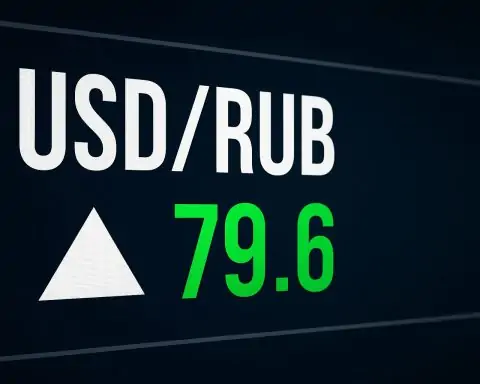Key facts: Oil prices have plunged to five-month lows amid a supply glut and demand worries. U.S. WTI crude recently hit about $58.7/barrel (Nov futures) and Brent ~$62.7 [1] [2] – the weakest levels since May. Traders say the slide was triggered by rising OPEC+ output and a U.S.–China trade war scare (Trump’s 100% tariffs triggered a rapid selloff) [3] [4]. The IEA now forecasts an unprecedented ~4 million barrels/day supply surplus in 2026 [5]. OPEC’s Secretary-General Haitham al Ghais warns $18.2 trillion of new oil investment is needed through 2050 to avoid future shortages [6]. Banks and analysts are growing bearish: Bank of America predicts Brent at ~$61 in Q4 2025 but says a worsening trade war and OPEC+ hikes could drive Brent below $50 [7]. On the corporate side, Occidental Petroleum’s CEO expects oil to stay “tight and range-bound” around $58–62 through 2026 [8]. Meanwhile U.S. producers like ExxonMobil see today’s oversupply as temporary, with long-term demand tightening absent new investment [9]. Investors have rotated into safe-havens: gold just broke all-time highs above $4,200/oz as fear and Fed rate-cut bets sent money into bullion [10]. Even as oil crumbles, North American oil stocks have held up — e.g. Occidental’s stock is buoyed by a recent $9.7B Berkshire Hathaway deal [11] and Canadian Natural’s shares hit near three-year highs on strong earnings forecasts [12].
Supply Glut and Trade War Pressures Push Oil Lower
Crude oil markets have entered a steep downtrend. In mid-October, WTI crude fell below $59 (for the first time since May) and Brent approached $62. Trading platforms show WTI trading around $58.70 and Brent near $62.40, down about 4% on Oct. 14 [13] [14]. That drop erased almost all of the “geopolitical risk premium” built up earlier in 2025 [15]. The selloff was triggered by a dual shock: easing Middle East tensions (an Israel–Gaza ceasefire) removed a premium on oil, while U.S.–China trade tensions surged again. President Trump’s threat of 100% tariffs and China’s retaliation (port fees and export curbs) panicked traders, who dumped riskier assets – including oil [16]. In fact, WTI plunged from about $61.50 to $58.70 in under four hours after the tariff news [17]. On Oct. 15, DTN reported WTI Nov futures at $59.15 and Brent Dec at $62.74, a sharp rebound but still in a bearish range [18].
The demand outlook is also weakening. Goldman Sachs warns that U.S. tariffs and weak data could shave up to 0.8 mmbpd off expected demand growth [19]. Earlier this week, oil traders feared a full-scale trade war would “severely crush oil demand” [20], and they moved to sell. The U.S. dollar’s recent strength and growing recession worries have added pressure on commodities. Together, rising supply and a dimmer demand picture have traders scrambling for protection – evidenced by oil futures curves sliding into contango (near-term prices below future prices) as inventories mount [21] [22].
Record Oversupply Warnings from IEA and OPEC
Major energy agencies confirm the glut is record-breaking. On Oct. 14, the International Energy Agency (IEA) raised its 2026 oil surplus forecast to nearly 4.0 million barrels per day – the highest annual overhang ever [23] [24]. Global inventories are at multi-year highs (U.S. stockpiles 4-year high in August) [25]. The OPEC Monthly Report also points to a shifting outlook: after earlier predicting a 2026 supply shortfall, OPEC now sees global supply roughly matching demand if all planned output proceeds [26]. In fact, OPEC’s own data show a narrowing supply deficit ahead, even as it maintains that demand will grow robustly [27].
OPEC’s chief, Haitham al Ghais, sounded the alarm at a recent forum. He warned that “to sustain supply and meet long-term demand” the world must invest $18.2 trillion in oil and gas projects by 2050 [28]. Al Ghais specifically criticized the IEA for flip-flopping on investment guidance, saying “the rhetoric of no new projects is damaging global energy security” [29]. His point: although markets are bearish now, chronic underinvestment risks a future crunch. ExxonMobil CEO Darren Woods echoed the theme. Speaking Oct. 13 in London, Woods said today’s oversupply is “likely to be a short-term issue,” as emerging-market demand eventually makes meeting global energy needs much tougher [30]. He warned that without big boosts in unconventional oil-and-gas drilling, the natural decline from old fields could be as high as 15% per year [31] – underscoring how the oil market’s long-term balance remains delicate.
OPEC+ Balances Output and Market Share
Despite warnings, OPEC+ has largely kept pumping. Secondary sources report that OPEC+ lifted production by ~630,000 barrels/day in September [32], led by Saudi, Russia and Iran. This added capacity comes as major non-OPEC producers (the U.S., Brazil, Guyana, Argentina, etc.) have also surged to record output. The combined result is oversupply that many analysts say “global demand cannot absorb” [33].
At its Oct. 5 meeting, OPEC+ again chose a cautious tone. Instead of an aggressive output hike, members agreed to a small 137,000 bpd increase for November – the same tiny raise as for October [34]. By historic standards, 137k bpd is almost negligible (about 0.14% of world output) [35]. This modest move surprised traders who had feared a larger Saudi/Russian compromise. Behind the scenes there was a sharp debate: Russia, already constrained by sanctions, lobbied for sticking with 137k; Saudi Arabia initially pushed to “double, triple or even quadruple” that base amount (up to ~548k bpd) to regain market share [36]. In the end, the small hike was a compromise. Energy analyst Jorge León of Rystad Energy notes OPEC’s dilemma: it must balance “maintaining stability” in prices with “clawing back market share in a surplus environment” [37].
The market reaction was telling. In the days ahead of the meeting, oil fell as traders braced for big supply. When the 137k bpd figure was finally announced, prices actually ticked up briefly: Brent spiked +1% on Oct. 6 before settling, and WTI climbed above $61.5 [38]. Analysts at ANZ noted that the small hike “staved off fears of an even bigger surplus” [39]. But that relief was short-lived. By Tuesday, Oct. 14, Brent was back in the low-$60s and WTI under $59. Traders concluded that while OPEC+ had shown restraint, global supply was still growing faster than demand. As one TS2 roundup put it, “surging output and sluggish demand have offset most bullish news”, suggesting that oil’s recent lows could become a new plateau [40].
Analyst Forecasts: A Flat Outlook Through 2026
With fundamentals so weak, forecasters see little upside near-term. Bank of America analysts on Oct. 15 warned that if U.S.–China tensions worsen while OPEC+ continues pumping, Brent could slip below $50 [41]. Their baseline scenario is still modestly positive: BoA keeps Brent at ~$61 for Q4 2025 and ~$64 in H1 2026, implying a floor near $55 [42]. But they explicitly cite the risk: “if trade tensions intensify…Brent prices could slip below $50.” In other words, fundamentals could surprise further on the downside.
Government agencies likewise see prices drifting lower. The U.S. EIA’s latest Short-Term Energy Outlook (Oct 2025) forecasts Brent around $62 in Q4 2025 and then sliding to ~$52 by 2026 [43]. The IEA’s new report cut its demand outlook while raising supply, implying a major surplus next year [44] [45]. Investment banks are generally cautious: Macquarie warns of a looming “super glut” and UBS notes that recent geopolitical shocks (like Russian refinery attacks) haven’t bucked the downtrend [46] [47].
Technically, oil looks stuck in a bearish range. Trading charts show WTI trapped in a descending channel since mid-September [48]. Key resistance is around $60–61 for WTI and $64 for Brent; support lies near $57 (WTI) and $61 (Brent) [49] [50]. Momentum indicators are oversold but not showing a clear turn yet. Short-term traders are eyeing roughly $55.90–62.20 as the possible trading range for WTI [51], with Brent’s ceiling near ~$64.50. A break below those zones could accelerate the slide toward the $50s, while a sustained break above would be needed to prove the downtrend is over.
Impact on Oil Stocks and Investors
The commodity rout is reflected in energy stocks, though with mixed effects. U.S. supermajors ExxonMobil and Chevron have strong balance sheets (Exxon’s H1 2025 free cash flow topped $23 billion) and have held up better than many expected. Exxon’s CEO Woods insists the long-term market will tighten, helping investor confidence [52]. Occidental Petroleum (OXY), meanwhile, has taken bold steps to de‑risk: in early October it announced a $9.7 billion all-cash sale of its OxyChem division to Berkshire Hathaway [53]. The deal (Oxy’s largest since acquiring OxyChem) will cut debt substantially (using ~$6.5B to drop net debt below $15B) and was viewed positively by shareholders [54]. OXY shares traded around ~$47–48 in early October (near the low end of their $34–56 52-week range) [55]. CEO Vicki Hollub told investors that despite current weakness, oil is likely to stay “range-bound” between $58 and $62 through 2026 [56] – a statement reflecting a broadly cautious corporate outlook.
In Canada, oil producers have seen strong rallies. Techstock² reports that Canadian Natural Resources (CNQ) stock surged to ~C$45.55 on Oct. 9 [57], close to a three-year high. CNQ’s rise has been driven by solid Q2 earnings (production +12% YoY, robust cash flow) and a dividend-yielding value proposition. Analysts remain upbeat: RBC Capital reiterates CNQ as a “top oil pick” with a C$62 target (implying ~25% upside) [58], while Scotiabank raised its target to C$58 [59]. By contrast, peers like Cenovus (CVE) are in takeover mode (CVE boosting its bid for MEG Energy), suggesting sector consolidation. (For context, CNQ’s trading around C$45 on the TSX is about $31 USD on the NYSE.) Overall, TS2 notes CNQ’s forward P/E (~11×) is cheaper than U.S. peers (~13–17×) [60], and the company boasts a 5.1% yield and top-quartile profitability.
Broad market sentiment, however, has been mixed. On Oct. 15 Wall Street actually rallied (the S&P 500 rose ~0.7%) as strong bank earnings and rate-cut hopes offset the drag from weak commodities [61]. In other words, the equities selloff triggered by trade fears in early October partially reversed. But energy sector stocks remain under pressure. In summary, most analysts have a neutral to mildly bearish stance on oil equities: they expect profits to hold up in the near term (due to cost cuts and high refining margins) but warn that $50 oil or below would hit earnings significantly.
Safe Havens Surge as Oil Falters
As oil—and wider markets—sputter, investors have fled to traditional safe havens. Gold has exploded to record levels, breaking $4,200/oz on Oct. 15 [62]. “The metal has been on a tear,” notes City Index analyst Fawad Razaqzada, who adds that renewed U.S.–China tensions give “even more reason to hedge … long equity bets by diversifying into gold” [63]. Silver and other precious metals have also hit new highs. This rotation into gold (up ~60% YTD) reflects the risk aversion spurred by oil’s slide, trade war jitters, and hopes that central banks will cut rates.
On the crypto side, Bitcoin and tech stocks have been volatile but remain relatively resilient compared to energy. (For example, NVIDIA reached ~$185 on Oct. 15 as AI demand swelled [64].) Overall, the strong dollar and Fed policy outlook – traders now fully price a quarter-point Fed cut in Oct and Dec [65] – have helped support stock indexes even as commodities suffer.
Outlook: In the $50s for Now, but Watch the Pivot Points
The consensus is clear: Oil prices are unlikely to stage a sustained comeback until the supply/demand balance visibly tightens. High inventories, aggressive OPEC+ output plans, surging U.S. shale, and a murky economic outlook suggest a bearish consolidation through year-end. TS2’s tradingnews analysis concludes with a “hold” bias on oil, warning of downside risk toward the mid-$50s short-term [66]. The channel is set: roughly $55–$62 for WTI in coming weeks, with Brent’s ceiling near ~$64 [67].
Key catalysts to watch include: U.S.–China trade developments (any resolution could boost demand expectations), OPEC+ policy shifts (production cuts or larger hikes would swing supply assumptions), and China’s actual import data (due mid-October) [68]. On the macro side, Fed decisions and global growth signals will influence dollar and commodity demand. If global growth fears deepen or trade policy worsens, analysts warn Brent could test the $40s [69]. Conversely, any shock that re-tightens supply (e.g. major OPEC cuts, renewed military risk) could stop the slide.
For oil stocks, the outlook is tied to this price range. Companies with low costs (U.S. shale, integrated majors) can survive low-$60s, but drilling budgets and dividends may still be revised if oil stays depressed. Investors will be watching which energy companies can maintain cash flows – Occidental’s debt reduction and CNQ’s high yield are positives – and which are overleveraged.
In short, oil is being treated by markets as range-bound and vulnerable. As one trade floor veteran put it, markets are “walking a tightrope” between too much supply and any glimmer of improving demand [70]. Until that dynamic shifts, experts expect oil to remain stuck in the $50–$60 bracket, with further declines likely if current trends continue [71] [72].
Sources: Industry news and analysis from TradingNEWS, TS2.Tech, Reuters, Rigzone/Bloomberg, DTN, and others [73] [74] [75] [76] [77] [78] [79]. These include expert comments (OPEC, CEOs, analysts) and the latest market data.
References
1. www.tradingnews.com, 2. www.rigzone.com, 3. www.tradingnews.com, 4. www.rigzone.com, 5. www.rigzone.com, 6. www.tradingnews.com, 7. www.reuters.com, 8. www.tradingnews.com, 9. www.reuters.com, 10. www.reuters.com, 11. ts2.tech, 12. ts2.tech, 13. www.rigzone.com, 14. www.tradingnews.com, 15. www.tradingnews.com, 16. www.tradingnews.com, 17. www.tradingnews.com, 18. www.dtnpf.com, 19. ts2.tech, 20. ts2.tech, 21. www.dtnpf.com, 22. www.rigzone.com, 23. www.rigzone.com, 24. ts2.tech, 25. www.dtnpf.com, 26. www.reuters.com, 27. www.reuters.com, 28. www.tradingnews.com, 29. www.tradingnews.com, 30. www.reuters.com, 31. www.reuters.com, 32. www.tradingnews.com, 33. www.tradingnews.com, 34. ts2.tech, 35. ts2.tech, 36. ts2.tech, 37. ts2.tech, 38. ts2.tech, 39. ts2.tech, 40. ts2.tech, 41. www.reuters.com, 42. www.reuters.com, 43. www.tradingnews.com, 44. www.rigzone.com, 45. ts2.tech, 46. ts2.tech, 47. ts2.tech, 48. www.tradingnews.com, 49. www.tradingnews.com, 50. www.tradingnews.com, 51. www.tradingnews.com, 52. www.reuters.com, 53. ts2.tech, 54. ts2.tech, 55. ts2.tech, 56. www.tradingnews.com, 57. ts2.tech, 58. ts2.tech, 59. ts2.tech, 60. ts2.tech, 61. www.tradingnews.com, 62. www.reuters.com, 63. www.reuters.com, 64. www.tradingnews.com, 65. www.reuters.com, 66. www.tradingnews.com, 67. www.tradingnews.com, 68. www.tradingnews.com, 69. www.reuters.com, 70. ts2.tech, 71. www.tradingnews.com, 72. www.reuters.com, 73. www.tradingnews.com, 74. www.rigzone.com, 75. www.tradingnews.com, 76. www.reuters.com, 77. www.reuters.com, 78. ts2.tech, 79. www.reuters.com










